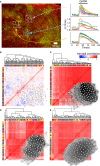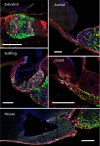Functional Pituitary Networks in Vertebrates
- PMID: 33584547
- PMCID: PMC7873642
- DOI: 10.3389/fendo.2020.619352
Functional Pituitary Networks in Vertebrates
Abstract
The pituitary is a master endocrine gland that developed early in vertebrate evolution and therefore exists in all modern vertebrate classes. The last decade has transformed our view of this key organ. Traditionally, the pituitary has been viewed as a randomly organized collection of cells that respond to hypothalamic stimuli by secreting their content. However, recent studies have established that pituitary cells are organized in tightly wired large-scale networks that communicate with each other in both homo and heterotypic manners, allowing the gland to quickly adapt to changing physiological demands. These networks functionally decode and integrate the hypothalamic and systemic stimuli and serve to optimize the pituitary output into the generation of physiologically meaningful hormone pulses. The development of 3D imaging methods and transgenic models have allowed us to expand the research of functional pituitary networks into several vertebrate classes. Here we review the establishment of pituitary cell networks throughout vertebrate evolution and highlight the main perspectives and future directions needed to decipher the way by which pituitary networks serve to generate hormone pulses in vertebrates.
Keywords: evolution; networks; pituitary; plasticity; vertebrates.
Copyright © 2021 Santiago-Andres, Golan and Fiordelisio.
Conflict of interest statement
The authors declare that the research was conducted in the absence of any commercial or financial relationships that could be construed as a potential conflict of interest.
Figures





Similar articles
-
Landmark discoveries in elucidating the origins of the hypothalamic-pituitary system from the perspective of a basal vertebrate, sea lamprey.Gen Comp Endocrinol. 2018 Aug 1;264:3-15. doi: 10.1016/j.ygcen.2017.10.016. Epub 2017 Oct 27. Gen Comp Endocrinol. 2018. PMID: 29111305 Review.
-
Gonadotrope plasticity at cellular, population and structural levels: A comparison between fishes and mammals.Gen Comp Endocrinol. 2020 Feb 1;287:113344. doi: 10.1016/j.ygcen.2019.113344. Epub 2019 Nov 30. Gen Comp Endocrinol. 2020. PMID: 31794734 Review.
-
The Processes of Anterior Pituitary Hormone Pulse Generation.Endocrinology. 2018 Oct 1;159(10):3524-3535. doi: 10.1210/en.2018-00508. Endocrinology. 2018. PMID: 30020429 Review.
-
Endocrine cells and blood vessels work in tandem to generate hormone pulses.J Mol Endocrinol. 2011 Aug 25;47(2):R59-66. doi: 10.1530/JME-11-0035. Print 2011 Oct. J Mol Endocrinol. 2011. PMID: 21622530 Review.
-
Neurone-glia interactions in the hypothalamus and pituitary.Trends Neurosci. 1996 Aug;19(8):363-7. doi: 10.1016/0166-2236(96)10055-2. Trends Neurosci. 1996. PMID: 8843607 Review.
Cited by
-
Ontogenetic changes in the tyrosine hydroxylase immunoreactive preoptic area in the small-spotted catshark Scyliorhinus canicula (L., 1758) females: catecholaminergic involvement in sexual maturation.Front Neuroanat. 2024 Jan 4;17:1301651. doi: 10.3389/fnana.2023.1301651. eCollection 2023. Front Neuroanat. 2024. PMID: 38239387 Free PMC article.
-
Association between Intracellular Calcium Signaling and Tumor Recurrence in Human Non-Functioning Pituitary Adenomas.Int J Mol Sci. 2024 Apr 3;25(7):3968. doi: 10.3390/ijms25073968. Int J Mol Sci. 2024. PMID: 38612778 Free PMC article.
-
Differential peptide-dependent regulation of growth hormone (GH): A comparative analysis in pituitary cultures of reptiles, birds, and mammals.Heliyon. 2024 Jun 14;10(12):e33060. doi: 10.1016/j.heliyon.2024.e33060. eCollection 2024 Jun 30. Heliyon. 2024. PMID: 38994081 Free PMC article.
-
Evidence that the pituitary gland connects type 2 diabetes mellitus and schizophrenia based on large-scale trans-ethnic genetic analyses.J Transl Med. 2022 Nov 3;20(1):501. doi: 10.1186/s12967-022-03704-0. J Transl Med. 2022. PMID: 36329495 Free PMC article.
-
Single nucleus/cell RNA-seq of the chicken hypothalamic-pituitary-ovarian axis offers new insights into the molecular regulatory mechanisms of ovarian development.Zool Res. 2024 Sep 18;45(5):1088-1107. doi: 10.24272/j.issn.2095-8137.2024.037. Zool Res. 2024. PMID: 39245652 Free PMC article.
References
-
- Rathke H. Ueber die Entstehung der Glandula pituitaria. Arch Anat Physiol Sci Med (1838) 40:482–5.
Publication types
MeSH terms
LinkOut - more resources
Full Text Sources
Other Literature Sources

